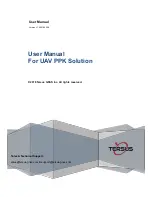
bdi
SCI
JTAG debug interface for SeeCode™ Debugger, BDI2000 (PPC744x/745x)
User Manual 16
© Copyright 1999-2003 by ABATRON AG
V 1.00
4 BDI working modes
dialog box «BDI Working Mode»
With this dialog box you can define how the BDI interacts with the target system.
Identification
Enter a text to identify this setup.
Startup
Startup mode defines how the BDI interacts with the target processor after
reset or power up. The options RESET, STOP or RUN can be selected.
CPU Type
Select the CPU family type of the target system.
JTAG Clock
This option allows to select the used JTAG clock rate.
Run Time
When startup mode STOP is selected, this option allows to set the run
time after reset in milliseconds until the target CPU is stopped. Values
from 100 (0.1 sec) till 32000 (32 sec) are accepted.
Workspace
In order to speed up code download, enter the address of a free 256 byte
RAM area. The BDI will install there some code that supports faster pro-
gram download. A value of 0xFFFFFFFF disables the workspace. The BDI
also needs this workspace to flush the data cache and to access L2 pri-
vate memory.
Catch exceptions
Check this switch if the BDI should catch unhandled exception. Catching
exceptions is only possible if the memory at address 0x00000100 to
0x00001FFF is writable and the vector table is mapped to 0x00000000
(MSR[IP] = 0).
Flush L3 cache
Check this switch if the BDI should flush the target cache before accessing
memory. This is mainly useful if there is an enabled L3 cache. If this switch
is not set, the BDI uses L1/L2 cache coherent read and write accesses to
target memory. Coherent access means, that the L1/L2 cache is directly
read or written via COP if the appropriate cache line is valid. In order to
flush the cache, the BDI needs some workspace in target RAM to execute
the flush code.
Transmit
Click on this button to send the initialization list and the working mode to
the BDI. This is normally the last step done before the BDI can be used
with the debugging system.
















































